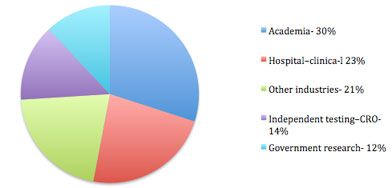Market Profile: Flow Cytometry
Flow cytometry is an analytical technique utilized to examine the physical and chemical properties of cells and microparticles, including beads. This method exploits a wide range of disciplines to elucidate information such as size, shape, DNA content, surface receptors and membrane permeability as well as to count the cells in a sample.
Flow cytometry is an analytical technique utilized to examine the physical and chemical properties of cells and microparticles, including beads. This method exploits a wide range of disciplines to elucidate information such as size, shape, DNA content, surface receptors and membrane permeability as well as to count the cells in a sample. Sorting capabilities are based on fluorescence activity that is measured while the sample is in flow.

Flow cytometry demand by industry for 2011
The first step for analysis by flow cytometry is to label the sample cells or beads with fluorescent dyes that bind only to specific components of interest. Samples are then suspended in a liquid and injected into the flow cytometer. Under precise, controlled conditions, the sample is subjected to the phenomenon of laminar flow, whereby the injected sample is constrained to the center of a fluid stream. This forces the sample of cells or beads to proceed in a single file fashion, passing through a laser beam that excites the fluorescent dyes. Each cell or bead will also cause the laser beam to scatter in a specific pattern, which is a function of the shape, size, and structure of the cell or bead. Information is collected and analyzed by the system’s data analysis system.
Academia, hospital–clinical, independent testing–contract research organization (CRO), and government research are the top four industries using flow cytometers, with a combined market share of nearly 80%. The three types of technologies included in this category are full-scale analyzers, sorters, and benchtop–compact cytometers. Although full-scale analyzers account for the majority of the flow cytometry market, compact flow cytometers are expected to grow the fastest for the next few years.
The foregoing data were extracted and adapted from SDi’s Market Analysis and Perspective report entitled A Complete Life Science Perspective. For more information, contact Glenn Cudiamat, VP of Research Services, Strategic Directions International, Inc., 6242 Westchester Parkway, Suite 100, Los Angeles, CA 90045, (310) 641-4982, fax: (310) 641-8851, e-mail: cudiamat@strategic-directions.com
Regulatory Deadlines and Supply Chain Challenges Take Center Stage in Nitrosamine Discussion
April 10th 2025During an LCGC International peer exchange, Aloka Srinivasan, Mayank Bhanti, and Amber Burch discussed the regulatory deadlines and supply chain challenges that come with nitrosamine analysis.
Top Execs from Agilent, Waters, and Bruker Take the Stage at J.P. Morgan Healthcare Conference
January 16th 2025The 43rd Annual Healthcare J.P. Morgan Healthcare Conference kicked off in San Francisco earlier this week. Here’s what top executives from Agilent, Bruker, and Waters, discussed during the event.

.png&w=3840&q=75)

.png&w=3840&q=75)



.png&w=3840&q=75)



.png&w=3840&q=75)

